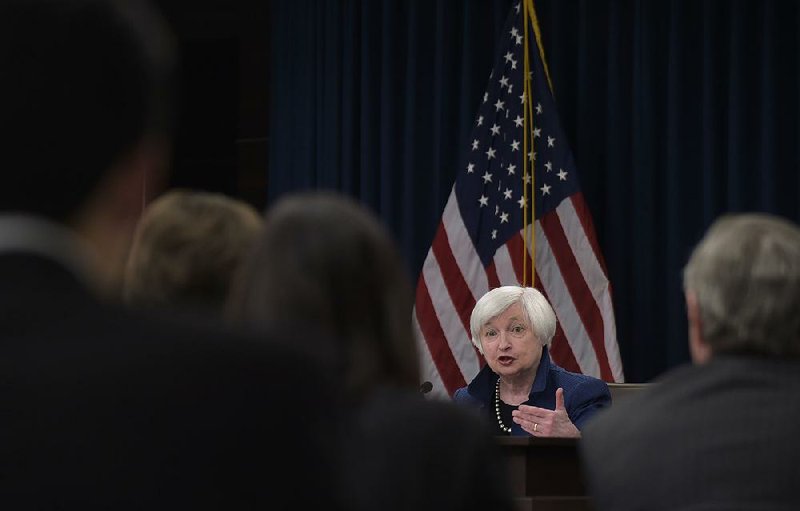WASHINGTON -- The Federal Reserve on Wednesday raised its benchmark interest rate for the second time in three months and forecast two additional increases this year. The move will likely mean higher rates on some consumer and business loans.
The Fed's key short-term rate is rising by a quarter-point to a still-low range of 0.75 percent to 1 percent. The central bank said in a statement that a strengthening job market and rising prices had moved the economy closer to the Fed's targets for employment and inflation.
The message the Fed sent Wednesday is that, nearly eight years after the recession ended, the economy no longer needs the support of ultralow borrowing rates and is healthy enough to withstand steadily tighter credit.
"In view of realized and expected labor market conditions and inflation, the committee decided to raise the target range for the federal funds rate," the Federal Open Market Committee said in its statement Wednesday. "Near-term risks to the economic outlook appear roughly balanced."
The decision, issued after the Fed's latest policy meeting, was approved 9-1. Neel Kashkari, president of the Fed's regional bank in Minneapolis, was the dissenting vote. The statement said Kashkari preferred to leave rates unchanged.
"Our decision to make another gradual reduction in the amount of policy accommodation reflects the economy's continued progress," Fed Chairman Janet Yellen told reporters. "Today's decision is in line with that view and does not represent a reassessment."
The Fed's forecast for future increases, drawn from the views of 17 officials, projects that it will raise rates three times this year, including the increase announced Wednesday. The number of Fed officials who think three rate changes will be appropriate for 2017 rose from six to nine.
"This is a sea change for them, to start talk about raising rates at a faster pace," said Blu Putnam, CME Group's chief economist.
The Fed has long insisted that it will match the pace of its interest rate changes to the progress of the economy. And in recent months, the U.S. economy has shown signs of heating up.
"It feels like we are at a transition to somewhat more regular increases," said Michael Feroli, chief U.S. economist at JPMorgan Chase. In the past, the Fed "just didn't get the global headroom" to be able to raise rates, he said. "I think for now, the coast looks clear."
The central bank's outlook for the economy predicts growth of 2.1 percent this year and next year before it slips to 1.9 percent in 2019. Those forecasts are far below the 4 percent growth that President Donald Trump has said he can produce with his economic program.
The Fed's rate increase should have little effect on mortgages or auto and student loans. The central bank doesn't directly affect those rates, at least not in the short run. But rates on some other loans -- notably credit cards, home-equity loans and adjustable-rate mortgages -- will likely rise soon, though only modestly. Those rates are based on benchmarks such as the prime rate for banks, which moves in tandem with the Fed's key rate.
Mark Vitner, an economist at Wells Fargo, noted that the Fed's statement provided little hint of the timing of the next rate increase. The lack of specificity gives the Fed flexibility in case forthcoming elections in Europe or other unseen events disrupt the global economy.
"They don't want to prematurely set the table for a rate hike," Vitner said. "I think they're confident, but it's hard not to be cautious after we've had so many shocks over the years."
Stock prices rose and bond yields fell as traders reacted to the Fed's plans to raise rates gradually. The Dow Jones industrial average, which had been only modestly positive before the decision was announced at 1 p.m. Central time, closed with a gain of 112.73 points.
The Fed's statement made few changes from the last one issued Feb. 1. But it did note that inflation, after lagging at low levels for years, has picked up and is moving near the Fed's 2 percent target.
Many economists think the next increase will occur no earlier than June, given that the Fed probably wants time to assess the likelihood that Congress will pass Trump's program of tax cuts, deregulation and increased spending on infrastructure.
In recent weeks, investors had seemed unfazed by the possibility that the Fed would raise rates several times in the coming months. Instead, Wall Street has been sustaining a stock market rally on the belief that the economy will remain durable and corporate profits strong.
A robust February jobs report -- 235,000 added jobs, solid pay gains and a dip in the unemployment rate to 4.7 percent -- added to the perception that the economy is fundamentally sound.
That the Fed is no longer unsettling investors with the signal of forthcoming rate increases marks a sharp change from the anxiety that prevailed after 2008, when the central bank cut its key rate to a record low and kept it there for seven years. During those years, any slight shift in sentiment about when the Fed might begin raising rates was enough to move global markets.
The Fed has managed its control of interest rates with caution, beginning with an initial increase in December 2015. It then waited an entire year before raising rates again in December last year. But now, the economy is widely considered sturdy enough to handle modestly higher loan rates.
Information for this article was contributed by Martin Crutsinger and Christopher S. Rugaber of The Associated Press; by Ana Swanson of The Washington Post; and by Craig Torres, Christopher Condon and Jeanna Smialek of Bloomberg News.
A Section on 03/16/2017
